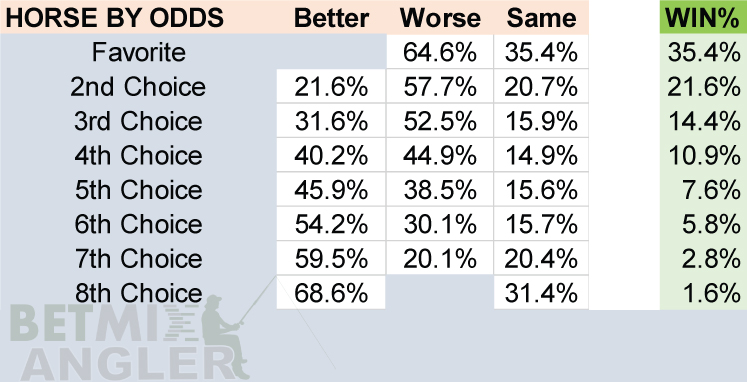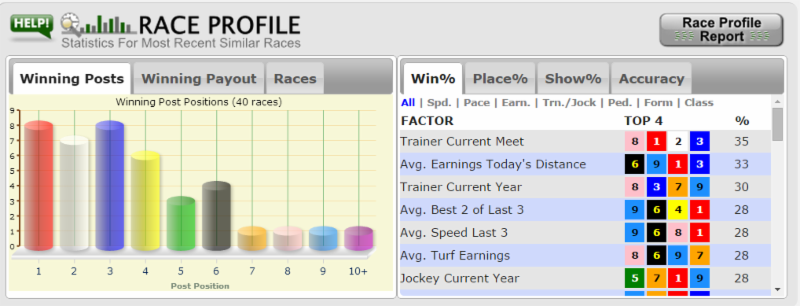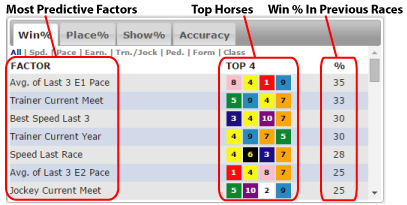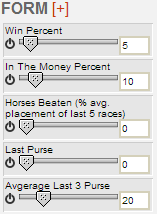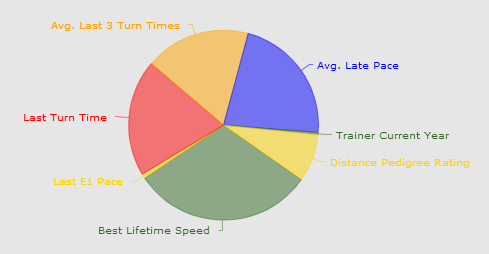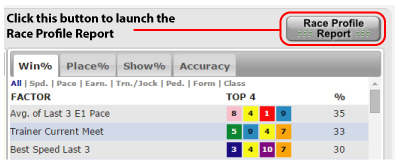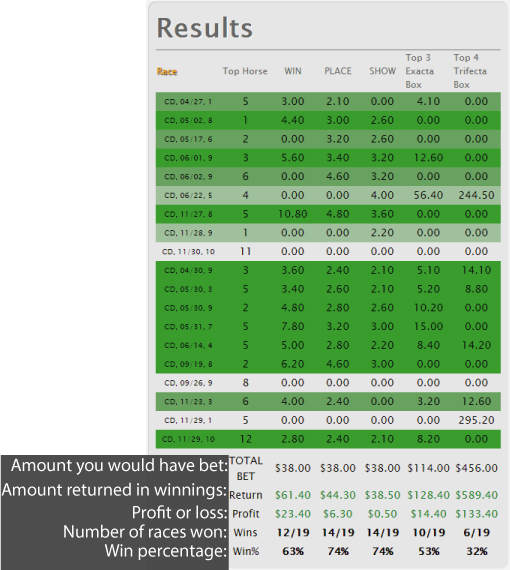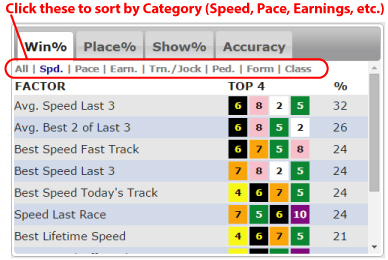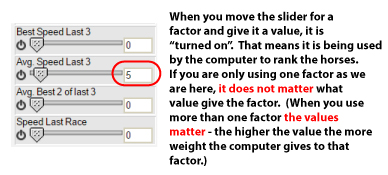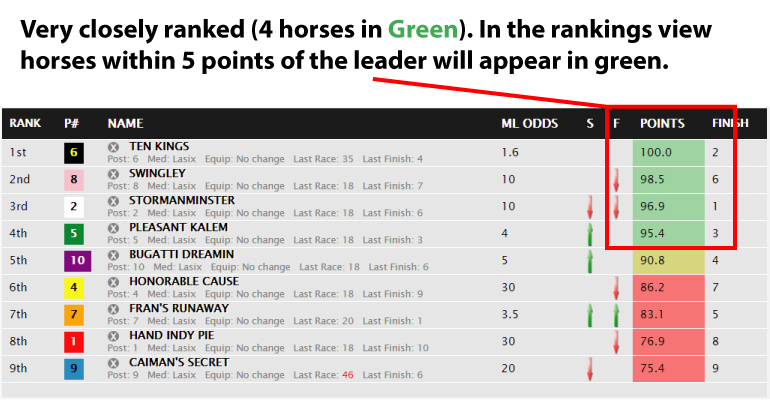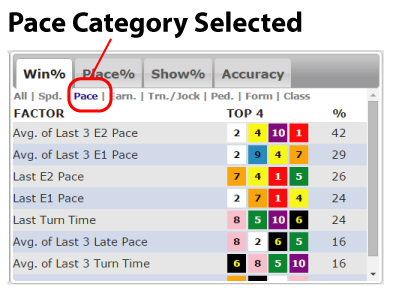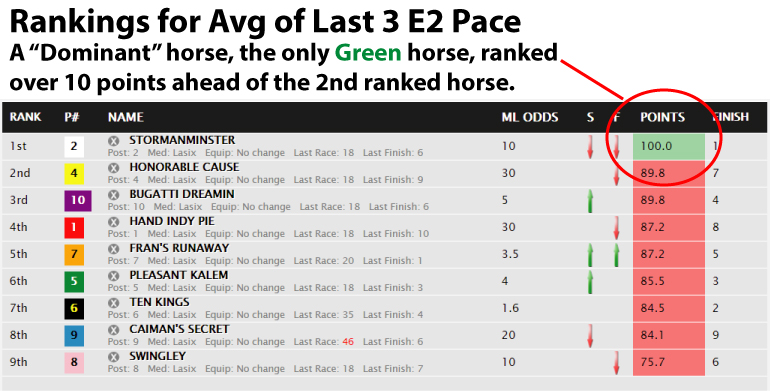| If you follow horse racing tournaments with any regularity, specifically a contest site called HorseTourneys, you know about the four “major” tournaments that comprise their yearly Grand Slam. This year, two Betmix customers, Matt Bickey and Mark Stillmock, were big winners. Bickey won the Player’s Championship in April, pocketing $149,310 in the process. Stillmock won $158,331 the inaugural Pick and Pray Classic in November, while also taking down the HorseTourneys Grand Slam Series with three Top 10 finishes in the four events. Both players have won multiple regular Tour events over the past few years, as well. With this year’s first major event coming this weekend, the Flo-Cal Faceoff on Feb 1-2, we invited both to participate in a written Q & A about the ways in which they use Betmix, and both were kind enough to oblige. We thank Matt and Mark for their time and hope that their generous insights will help you all win a few tournaments this year! |
| General Software Origin, Use & Strategy: BETMIX: How did you come to use Betmix? MB: (Matt Bickey) I make media, and occasionally trawl the internet for archival footage of things, and remixes of songs. I do periodic searches of words like "footage" and "mix" and scroll deep to see what they bring up. In an odd collision of my interests, my search for media brought me to Betmix. Up until that point I was a paper handicapper using BRIS products, and, on big days, using their ALL-WAYS software. When I found Betmix, I tested it for a couple of months before moving to it full-time. This was when you had what you now call the Legacy tools, before the development of Birddog and Angler. MS: [Mark Stillmock, P.E.] Dave, I do not remember exactly. I know that I became disenchanted with a competing product as I believe they were tweaking things, and it affected my selections. I believe I saw the ad in Xpressbet. I went to the site, and I liked the database style of organization, and the amount of information and I thought it would work for how I handicapped. BETMIX: Betmix offers a vast array of data and features. Can you walk me through your typical workflow when using the software to prepare for a tournament day? MB: Anyone who knows me knows that I think race selection is the Holy Grail, especially at an event like the National Handicapping Championship (NHC), but my usual day involves playing pick-and-pray events at HorseTourneys. In that case, the races are picked for you, so the first thing I usually do is pull each race up in the Birddog module and evaluate the favorites using a couple of my basic mixes. Mine are built around speed and pace figures, but for those just beginning, looking at factors with high percentages in the Top 4 column may be enough. What I am usually hoping for is races that have less than a 10-point difference in my mixes from top horse to bottom horse. Those races usually aren’t won by the favorite, and many times, produce a price. MS: I determine what races are included in the tournament. I write down the track, the race number, and the type of race, MC, MSW, ALW, etc. and each horse. Then I open Birddog, I analyze the race qualifying each horse based on whether it has a positive ROI in the owner stats, trainer stats, jockey stats, or sire stats. I circle any horses that have a positive ROI. My default sort is for positive ROI’s.Next, I look at the class analysis and determine which horses won their last time out, and I apply some handicapping to horse that won the last time out to qualify or disqualify them. Next, I look at the quick handicapping buttons, factor groups, score and birddog, and mixbot, and I circle any horses that are not yet circled. I look at the factor statistics, I sort on a Win ROI with the highest ROI at the top, and I circle any horses that show up here that are not yet circled. I look at the command center selections and I will circle any that have not yet been circled. If I still have some horses that are left not circled, I will check to see if the show up in Twinspires pace and tips. If they do I will mark them TS, so I can keep track of how they do. Then I will make my picks using my proprietary selection method. BETMIX: How do you prioritize the different data points available in Betmix (speed figures, class ratings, pace projections, trainer stats, jockey stats, etc.)? Do you rely on specific modules, and if so, which ones do you favor? MB: The thing with Betmix is there are just so many ways to use it. You have built so many quality modules over the years, and I would have to say that the way I play now, is very different from the way I played, say even two years ago. As your product has evolved, so have I. I predominantly use Fusion, Birddog, PP View (which is inside of Birddog), and Angler in conjunction with one another. When you released Fusion, which is based on the exact number of starters in a race, it wrecked my game for a few months before I figured out what I was looking for through a lot of backward-looking studies. Everything started to click around April, just in time for the Player’s Championship. If I had to pick just one module, now it would be Fusion. But I always look at several different things to narrow down selections, especially if I am in a game with only one entry. MS: If the contest is $2 live WP and I am at the end and I need something with specific odds, I primarily focus on Mixbot and Factor Statistics. In pick and pray contests, my selections are already made. I developed my current methodology for $2 win and place contests, and I am happy with where I am at there. I am working on live bankroll contests to figure out how I want to use Betmix in them. So far, I am focusing on Mixbot, Factor Statistics, and the Command Center, I pay special attention to class and pace. BETMIX: Do you utilize any custom filters or screens within Betmix to narrow down your contenders? If so, can you share some examples? MB: I do. I have 27 different mixes built in Fusion, and the consensus of those, which Fusion tabulates for me at the top of screen when “Load” is selected, has proven very powerful for me, especially in betting and live money games. I probably have hundreds of mixes built for individual tracks, distances and surfaces that I have made over the years, but honestly I only look at those now in a tie-breaking scenario. One example would be a mix I call “Hidden,” which is built around Days Since Last Race, Days Since Last Win, and Betmix’s proprietary class rating, in this case, showing a drop of 2 points or more. Many bombs have come from this simple mix in Fusion. MS: I do not, I have investigated them but found that the base Betmix data suits my needs better. BETMIX: How do you balance using the software's objective data with your own subjective handicapping insights and observations? MB: A lightbulb went on for me when I just eliminated my ego and accepted the fact that the data is smarter than I am. If you remember, I made t-shirts for my wife and I, and you, and some Betmix friends that said just that, and we wore them one day at the NHC last year. Many times, though, I will be between three or four horses, and I will use various things to break the tie. One of my favorites is to go into PP View in Birddog, and use the sliders to look at just the last year of races at roughly this distance and Betmix class, and see who gets kicked out. MS: In pick and pray, and live $2 contests, I stay with my picks, and I do not try to second guess myself. If the horse qualifies, it qualifies. I will only change things towards the ends of live $2 WP contests, and only if my initial selection does not meet the odds that I need. BETMIX: Betmix allows for creating "angles" and “mixes.” Do you use any pre-built ones? What are their key components? MB: As I mentioned above, I have a great many. Their components depend on the kind of race. Any race with firsters, or second-time starters, I only use Trainer, Jockey, Pedigree, and Owner, Owner/Trainer combo info. Betmix is great for that. I haven’t run across many other software suites that give you as much info on Owners as Betmix does. Races where horses have a lot more starts, and data, I put a lot of stock in the-top-to-bottom mixes I have built. They usually involve mostly class, speed and pace factors. MS: I do not, I have investigated them but found that the base Betmix data suits my needs better. BETMIX: Live-money tournament play requires managing a bankroll effectively. Does the Toteboarding module in Betmix inform your betting strategy in terms of wager type and amount? MB: The imputed odds from the Daily Double and Pick 3 pools are invaluable. But honestly, that is about all I look at. Once the race is off though, I always have Toteboarding open so I can see what the final exacta payouts are going to be. MS: I do not use the Toteboarding feature. Specific Feature Focus: BETMIX: Betmix offers advanced past performance data. Are there specific data points within the past performances that you find particularly insightful when using the software? MB: I am a huge fan of the PP View in Birddog. When I am telling a paper handicapper to check out the software for the first time, that is where I tell them to go first, because it looks somewhat like what they are used to. But its sortability is so powerful, and addictive, and the way it averages whatever is left on the screen is something. Example: set the slider for distance to exactly 6 furlongs, and the average speed par for the race alters to suit that, and horses that have never gone that distance disappear (I usually go a half furlong either way, by the way). It can really change the way you look at a race. And then, with regard to any factor, I look for what I call “the gap.” If a horse has a five-point advantage in any significant factor, like, say, Average Speed Best 2 of Last 3, it shouldn’t be ignored. MS: I have just started looking at them, I am trying to determine if I can use them in Live bankroll tournaments. BETMIX: Do you utilize Betmix's pace projections and how important are they to your handicapping process? MB: That is a tool that I don’t use. I do look for those aforementioned gaps of five points in all the e1 and e2 factors, though. MS: I will occasionally look at E1 or Late, to give me a quick graphical what the pace setups is. BETMIX: How much emphasis do you place on Betmix's trainer and jockey statistics? Are there specific stats you look for, or do you use the overall ratings? MB: As I mentioned earlier, quite a bit in any race with a firster or second-time starter. But I add in some pedigree and owner stuff as well. I don’t favor any of the trainer/jock stuff, specifically. I consider all those factors, with particular attention paid to win and place percentage. MS: They are integral to me selecting horses to be qualified. BETMIX: Does Betmix’s proprietary class and/or speed information influence your selections, and if so, how? MB: Again, in races where the horses have had a lot of starts, class and speed become vitally important. I especially love Betmix’s class rating. Many times I see a horse that appears to be rising in class by the race type, as in something like a 7500 CLM to 10000 CLM, but in Betmix, he will actually be on a two-or-three-point drop. I call that the “Hidden” drop. I especially love that scenario when that horse is the only horse with the highlighted-green class-drop indicator. MS: Yes, the class affects how I evaluate previous winners, if they are the top class I will qualify them. If the winning horse does not meet any of my criteria, or the Betmix class, I will check the Factor Statistics to see if the horse is tops in any speed category, if it is, it qualifies. Tournament-Specific Strategies:BETMIX: In a high-pressure tournament environment, how do you avoid "over-thinking" the data presented in Betmix? MB: Easy answer. Trust the data. It is right way more often than I am with my subjective opinion. Also, choose wisely. That is the hardest part, lol. Also, many years ago, when I was first getting serious about handicapping, I read Brad Free’s book “Handicapping 101,” and he said something in it that I still say to myself in just about every tournament situation: “be bold, or be wrong.” MS: I try to stay with my original picks in $2 WP live tournaments until the end when I may need something with specific odds to get me where I want to be. As for Live Bankroll tournaments, I am still developing how I want to use Betmix’s vast amount of data. BETMIX: Do you use Betmix differently when playing in a live-bankroll tournament versus a mythical-money tournament? MB: I don’t. It took me 10 years to become a good handicapper, and probably another 10 years to become a good gambler. Tournament play really did help me hone my game to being able to focus on one or two horses, and then a fellow who goes by the name of Inside The Pylons on Twitter, really helped me on the wagering side. I am sure I still don’t bet as efficiently as he would like, but I do pretty well. I heartily recommend anyone seek out any podcast he has done and really listen. If he rankles you, you’re probably playing incorrectly. The thing about live money tourneys is that it is about being good on that day. So I skew a little broader to improve my strike rate, and the way my game is designed, I will always have some kind of play at the end that will put me in contention. MS: Yes, to win you need some big numbers, you have to choose when and where to take a chance, one of the Betmix factors that I use is the longshot score for the race or sorted by the longshot score in the command center. I also use a database that I developed a few years ago tracking which races had the highest ROI’s and between that and Betmix I decide where to take my chances. BETMIX: Were there any specific races in the tournament where Betmix proved particularly crucial to your success? Can you walk me through your thought process in those instances? MB: Oh, God yes. Every big score I have had in the last 10 years. That HorseTourneys Breeder’s Cup Day tournament win in 2020 for 35k is what kind of moved me to the next level. And then, of course, the 149k win last April in the Player’s Championship. Betmix has been central to everything I have won since I found you in 2013, so thank you a million times over for creating it! As for my thought process with tournaments…it really doesn’t change. I like to do all the work, and have my selections put in before the post of the first race of the contest. This is because I mostly play lockdowns. I prefer them. Live win/place mythicals become dart-throwing contests a lot of times if someone scores early. It is so much better to have a bomb early rather than late in those, but even in Live WP mythical, I have all the work done before the first contest race. MS: It is integral to all my qualifying horses, so any winner that I picked, it was crucial to its selection. BETMIX: Longshots are the key to tournament success. Without divulging any secrets, can you tell me how you use Betmix to find those longshots in tournaments? MB: Well, I feel like I have sprinkled a few throughout the course of this, but I remember sitting with a really good player back at one of the first tournaments I ever played, a 3-seat NHC qualifier at Colonial Downs. I had a middling score of 50 bucks. I knew he had qualified multiple times before, and asked him if he would look at my plays (this is so far back…you wrote them on a triplicate carbon copy, submitted the white and yellow sheets in two different bins, and kept the pink one). He looked at them for two minutes, and said: “you can’t have longshots if you never take any, and you have to have longshots to play correctly.” This gentleman was the first to tell me that when you whiff in a contest, it usually means that your game theory is correct. You are playing in a manner that will win a tournament. It just didn’t win that day. Many, many players I meet never venture out past 12-1 morning lines. They would certainly never take a 30-1 morning line horse. The only way they catch a cap horse is if it gets lost on the board from 8-1 morning line or something. The process, for me, is: evaluate the favorite, and second choice, as well. Do you believe in them? If not, go to the longest-odds horse in the field and start working backward. As far as how I use Betmix, perhaps I shouldn’t give this away, but Win ROI is vastly more important to me than Win percentage. So, I sort everything I look at by Win ROI, and usually build mixes of those factors around any of them with an advantage of 4 points or more. This is why you so rarely see me on anything under 6-1. Although, I am trying to force myself into a mindset where if I see a horse just lays over the field, take the seven dollars and move on. This is something I really admire about Mark Stillmock’s play. I look at his selections, and mixed in with the bombs, he will have some really logical horses. That guy is on fire. I am kind of jealous, actually, not being the best user of Betmix at this moment, lol. I look forward to his answers in this space. MS: Like I said before, I use Betmix as my primary horse qualifying tool, and then I use my proprietary selection method for making my final selections. I will use specific Mixbot and Factor Statistics if I need a long shot at a specific point in a tournament. Future Development:BETMIX: Are there any features you'd like to see added to Betmix to further enhance its usefulness for tournament players? MB: Not to beat on a drum that I have told you privately, but I would love to see the Command Center module updated. After Handicapping Journal (which points out the big prices of the previous day, which I check out and back-handicap to see how those numbers could have been found), CC is the next thing I open. It gives a nice overview of where post times land, and its Longshot Score is part of my process. As I mentioned earlier, race selection is my personal Holy Grail. My dream is a Longshot score on 100-point scale, where a 51 means a better than coin-flip chance that the race will not be won by a favorite. A 1 means take the chalk, and a 100 means, bombs away. I have sought this for years, and it is part of the reason I have developed my own top-to-bottom mixes that aren’t meant to point to a winner, but rather a race that is more likely to produce a price. I do love how Betmix has never been a static product, and that is because of you. Every time you tell me a new module is in the works, I am excited to see what it will do. Birdog and Angler were a quantum leap from the legacy tool. Fusion was even better, after I figured out how to use it, than Birddog and Angler. I look forward to seeing what you come up with next. MS: When using the angler analysis to look at Owner Stats, Trainer Stats, Jockey Stats, and Sire Stats, it would be nice if they change if we make a change in the Factor Statistics, for example, if a track goes from fast to sloppy it would be nice to see the angler analysis change to reflect the now sloppy track. In Factor Statistics, it would be nice to show NA, or something similar when there is no horse qualified for that factor, instead of the 12345. When there is a 1x, 2b, or 3c factor statistics does not show the number, only an odd chiclet is shown and that can be challenging to figure out which horse it refers to.In the command center can you add the number of races that the longshot score is based on?I could not find it; I believe that I looked carefully but I may have missed it.If it is somewhere else, could you tell me where?Would it be possible to set up command center so that it will show the next days races, not just the current, and past two days?This last one would be nice to have, but it is not as important as the others. In the command center dials and selections, when the surface or track condition change, would it be possible to have the command center selections and dials change to match it? BETMIX: Knowing what you know now, and having been as successful as you have been, what advice would you give to someone just starting to use Betmix for tournament play? MB: You can’t be great every time you play (another personal dream of mine, lol). Well, unless your name is Mark Stillmock the last few weeks! So, I would say, be patient. If you whiff, don’t get down. It probably means you are playing correctly. My eldest son is getting into the game, and one day will get serious once he is out of school. I have told him, put $300 in HorseTourneys, and play max entries in 100 $1 games. Track everything you do, and revisit every game you play. I know far too many players who just do the same thing every time they play, and they never look back at what led them to their selection, win or lose. It is a grind, but I only got good from looking backward, a lot. I still look back at my plays, every single day. And another great thing about HorseTourneys is, that on every weekend, you can see how the very best players in North America played. Track them. That $100 horse they had in the last…go back and look at that race and find out which Betmix module might have pointed you toward it. This is an illogical game, the greatest gambling game ever invented, if you ask me. Punching in a few numbers the right way, can change your life in under two minutes. It is well worth anyone’s time to get good at it, with or without becoming a great tournament player. Not to be over the top, but I look at the races as canvases, and Betmix as a collection of paints and brushes that can help you create masterpieces. MS: Because of the large amount of information available in Betmix and the many ways to use it, you will need some time experimenting with it to determine what features fit you handicapping style. It took me around six months of tinkering to determine how I wanted to use it for $2 WP tournaments, and as I have said previously, I am still working on how to use it in live bankroll tournaments. What I did was keep track of mythical entries against the actual tournaments, that saves money and helps determine how you want to use Betmix. |


